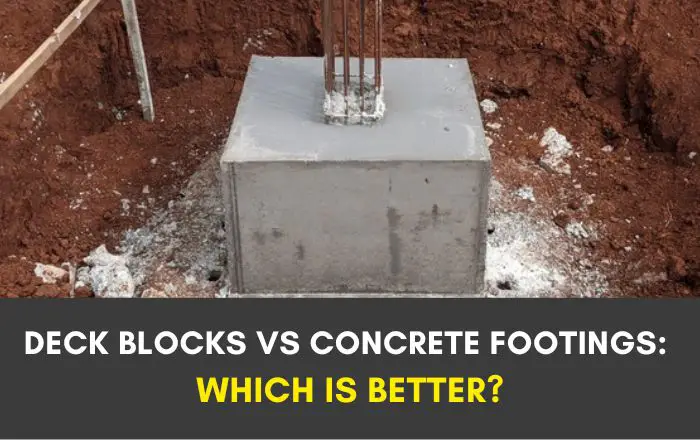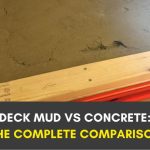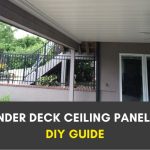Constructing a deck is an exciting endeavor, but the key to a long-lasting and stable deck lies in its foundation. The foundation choice can make or break the entire structure.
Among the plethora of options available, deck blocks and concrete footings stand out as the two most popular and reliable choices. But how do you decide between deck blocks vs concrete footings: which one is right for you?
Deck blocks are great for straightforward, quicker installations, especially for smaller decks. In contrast, concrete footings are suited for larger, more permanent structures, offering unmatched stability and durability.
In this detailed guide, I will dive deeper into both deck blocks and concrete footings, helping you make an informed decision for your deck.
What are Deck Blocks?
Deck blocks are sturdy concrete blocks designed to support your deck. They’re user-friendly and highly effective in creating a solid foundation for your deck.
Deck blocks are an ideal choice for DIY deck builders due to their ease of handling and installation. These blocks are typically placed directly on the ground and can be adjusted to ensure a level deck frame.
They come in various sizes and shapes, catering to different deck designs and requirements. Unlike traditional foundation methods, deck blocks do not require digging or extensive preparation of the site.
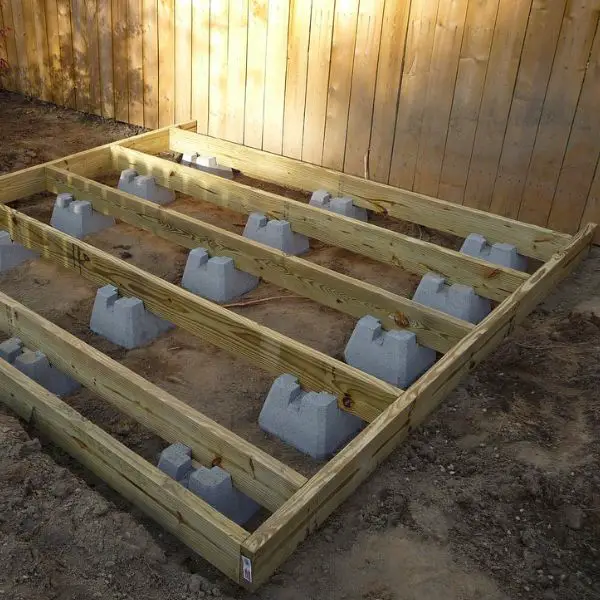
This makes them a quick solution for setting up a deck, particularly in areas where the ground is stable and not prone to frost heave or significant soil movement.
Their concrete composition ensures durability and resistance to weather elements, making them a reliable choice for outdoor structures.
Types of Deck Blocks
- Post Holder Deck Blocks: These have a special notch on top to securely hold a 4×4 post.
- Beam Support Deck Blocks: These come with a cross-shaped notch for directly supporting beams, removing the need for extra posts.
Key Features of Deck Blocks
- They’re about seven inches tall, giving them enough strength to support a deck.
- The number of blocks you need depends on your deck’s size and design.
- Space them out like regular deck posts for even support.
- Your deck should be no more than five feet above these blocks for stability.
- The block’s indentations might be wider than your beams, so you’ll need to join two beams for a snug fit, making this a two-person job.
- The deck’s weight helps keep it stable. It’s heavier downwards than sideways, reducing the impact of wind.
- Choose a spot not prone to soil erosion to ensure long-term stability.
Pros
- Just position them on the ground.
- Can be placed on any suitable surface.
- Available in different sizes and shapes.
- Easier to handle.
- Cheaper than concrete footings.
- Resistant to decay and weather impacts.
Cons
- Beams and posts are extra costs.
- Some may be defective or damaged.
- Need a perfectly stable surface.
- Might be harder to find solutions for problems.
What are Concrete Footings?
Concrete footings are strong foundations made by pouring concrete reinforced with steel bars into dug trenches.
They prevent your deck from sinking and provide a steady base. Concrete footings are essential for building structures that need deep, stable support, like large decks or in areas with unstable soil.
The process involves excavating the ground to a specific depth, often below the frost line, to ensure the footing remains stable throughout seasonal temperature changes.
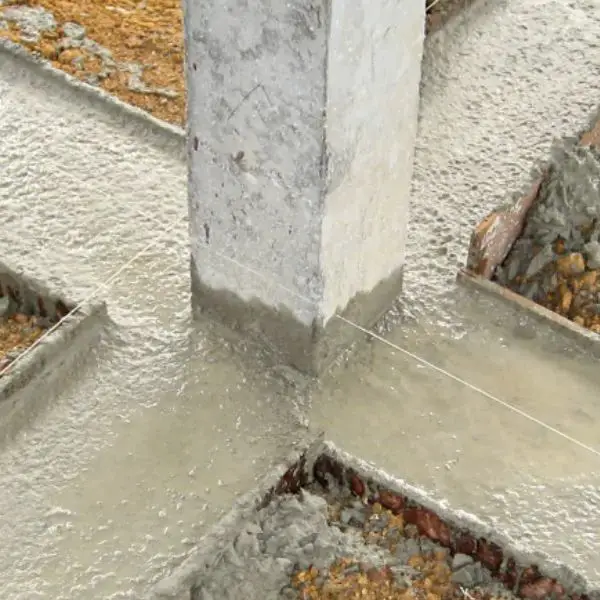
The addition of steel rebar within these footings adds extra strength and durability, making the foundation more resistant to shifting or cracking.
This method is particularly useful in regions with heavy frost, as it prevents the upward movement of the ground during freeze-thaw cycles.
Once set, concrete footings provide a long-lasting and robust base that can support significant weight and withstand harsh environmental conditions.
Features of Concrete Footings
- They extend deep into the ground, usually at least 12 inches below the frost line, to ensure stability.
- If the soil was previously dug up, you’ll need to go even deeper.
- The soil compresses around the posts in the footing, giving extra support.
- They protect your deck from damp soil, which means less worry about weeds, moisture, and termites.
- These footings are solidified by hammering steel posts into the ground, then pouring concrete over them. This process ensures your deck remains stable, even when the ground is wet or windy.
Installation Steps for Concrete Footings
- Excavate the ground to the required depth.
- Use a jackhammer to drive steel posts into the ground.
- Fill the excavated area with concrete.
- Ensure all footings are even and let them dry completely before building your deck on top.
Pros
- Made right where your deck will be.
- No worries about manufacturing defects or transport damage.
- Materials are readily available.
- Excellent for cold climates.
- Offers enhanced stability.
- Easy to find skilled workers for installation.
- Can handle more weight than deck blocks.
Cons
- Costs more, including labor.
- Takes longer to install.
- Difficult to fix if damaged.
- Can be higher.
Deck Blocks Vs Concrete Footings: Key Factors to Consider
Building a deck involves many decisions, but choosing the right foundation is crucial. Deck blocks and concrete footings are popular choices, each with their own set of advantages and drawbacks. Let’s break down what you need to know to make the best choice for your deck.
Cost
- Deck Blocks: A cost-effective choice, usually priced between $4 to $6 each. For a standard 10×8 foot deck, you might need around 9 blocks, totaling about $36 to $54.
- Concrete Footings: More expensive, ranging from $3 to $7 per square foot. For the same deck size, the cost could be between $240 to $560.
Simple Vs. Complex Setups
Deck blocks are easy to use. Just place them where you need them. They come ready-made, with indentations for installing posts.
Concrete footings require more work. You’ll need to dig, place rebar, and pour concrete. This often means hiring professionals if you’re not experienced in construction.
Durability Matters
Deck blocks are durable but can have issues. High humidity or frequent rains might cause them to sink or even crack under heavy weight. They’re not as stable as concrete footings and can soften if wet inside.
Concrete footings are extremely strong and stable. They’re buried deep, making them resistant to weather changes and heavy loads. Ideal for long-lasting, sturdy decks.
When to Choose Deck Blocks Vs Concrete Footings?
Concrete footings are the preferred option for long-term structures, particularly in areas prone to frost. They offer deep, stable support that extends below the frost line, preventing the deck from shifting due to freeze-thaw cycles.
This makes them ideal for larger decks or structures that need to endure harsh weather conditions and carry heavy loads over many years.
On the other hand, deck blocks are best suited for freestanding or floating decks, especially in regions with milder climates where the ground is stable and less likely to experience significant frost heave.
These blocks are more suitable for smaller, lightweight decks or when you are looking for a quicker, more cost-effective solution.
Deck blocks are also a great choice for temporary structures or in situations where you might need to move or adjust the deck in the future.
They offer flexibility and ease of installation but lack the deep, anchoring stability that concrete footings provide.
Can Deck Blocks Replace Concrete Footings?
Deck blocks are often viewed as a convenient and affordable foundation option, particularly appealing for smaller, less permanent structures or in scenarios where budget and ease of installation are major considerations.
However, they are generally not perceived as being as strong or durable as concrete footings. This is mainly due to their surface-level placement and limited depth, which can affect their stability and longevity, especially in challenging environmental conditions.
Concrete footings, in contrast, are recognized for providing a more solid and lasting base. They are typically wider and go deeper into the ground, offering enhanced stability and support, especially under heavy loads or in areas with significant ground movement, such as frost-prone regions.
Their depth below the frost line helps prevent shifting and settling, making them a more reliable choice for larger, permanent structures.
In essence, while deck blocks can be a suitable choice for certain types of decks, they do not generally replace the solid foundation and long-term resilience provided by concrete footings in more demanding construction scenarios.
Final Thoughts
Whether you choose deck blocks or concrete footings, it’s crucial to consider the factors like cost, installation ease, and durability.
Deck blocks work well for smaller, less permanent structures, while concrete footings are better for larger, permanent decks in challenging environments. Evaluate your deck’s needs and environment carefully to make the best decision for a strong and lasting deck foundation.
Hina Kanwal is the dynamic force behind Deckfaqs.com, blending her expertise in deck design with actionable insights. Known for her engaging content and practical advice, she empowers homeowners to elevate their outdoor spaces. Her passion and knowledge make her a trusted voice in the world of deck-building.

